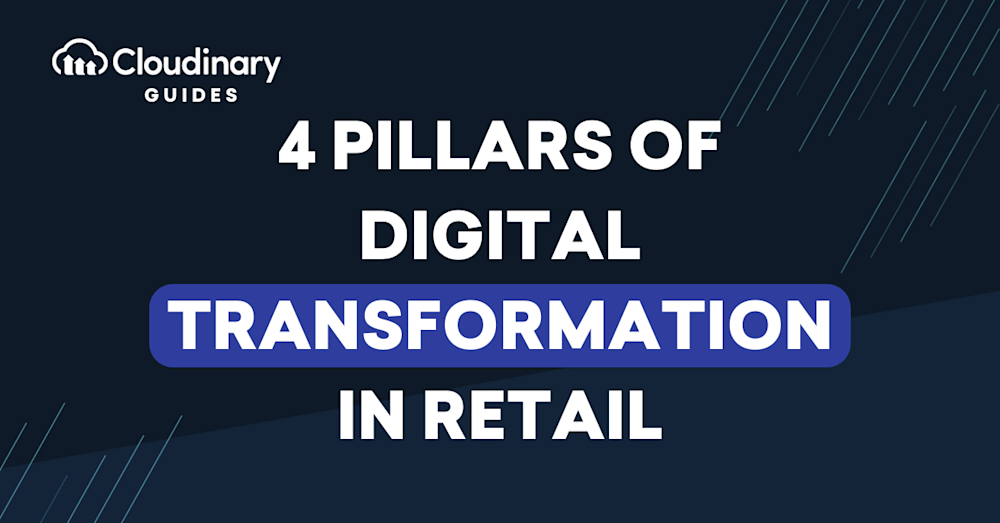What is Digital Transformation in Retail?
Digital transformation is the act of injecting new technologies into an organization to improve existing processes and enable new business activities. For retailers, this includes advancements like digital commerce, contactless ordering, roadside pickup, self-checkout systems, cost optimization based on big data analysis, and AI-powered product recommendations.
Beyond these specific initiatives, digital transformation can help retailers rethink how they approach their market, engage with customers across multiple channels, and create opportunities for new products, services, and business models.
We’ll discuss the main pillars of digital transformation initiatives in retail: promoting customer engagement, empowering employees, optimizing internal operations, and enriching products with digital technology.
In this article:
- Benefits of Digital Transformation for Retail
- Pillars of Digital Transformation in the Retail Industry
- Customer Engagement
- Employee Empowerment
- Optimizing Operations
- Enriching Products with Technology
- What Are the Key Trends Driving Digital Transformation Initiatives in Retail?
- Digital Commerce
- Systems Integration
- Voice Commerce
What’s Driving the Demand for Digital Transformation in Retail?
The global scale and impact of the retail industry, with a worth of $7T and employing more than 1.8 billion people, substantially drive the demand for digital transformation. The bigger the market, the larger the potential returns and gains from implementing digital changes. Additionally, the vast scale of employment denotes the industry’s complexity and the potential efficiencies and consistency that digital transformation can bring. These efficiencies can streamline procedures, reduce costs, and improve product effectiveness, all leading to better customer service and increased profitability.
The second major driver is the large number of consumers, around 3.2 billion, who now shop online worldwide. This factor forces retailers to adapt and match their online presence to their consumers’ growing digital expectations. Not to forget, the online milieu offers retailers unparallel access to customer data. When analyzed and utilized correctly, this data can enable retailers to create more personalized experiences, anticipate market trends, improve inventory management, and drive growth and customer loyalty. In essence, the increasing number of online shoppers worldwide necessitates a digital-first approach in retail.
Challenges in the Digital Transformation of the Retail Industry
Embracing the rewards of digitization in retail comes with its fair share of hurdles. Let’s go over some of the key challenges the retail industry is working to overcome:
- Coping with Change – Change is known to induce anxiety and resistance, especially when traditional retailers contemplate migrating towards a more digital foundation. Convincing stakeholders is key, but it requires a careful, well-planned strategy that anticipates and addresses their concerns, laying out clearly how digital methods will improve, rather than complicate, their existing structure.
- Budget Constraints – The transformation process doesn’t come cheap. Moving to a digital platform means investing in new technology and software, as well as training personnel to operate the new systems. For small and medium retailers, the financial commitment required could be overwhelming, creating a stumbling block on their path to digitization.
- Complexity – Introducing technologies like IoT, blockchain, and augmented reality into retail operations adds a layer of intricacy that not every retailer is prepared for. Understanding and properly using these technologies can be difficult, especially for people with limited technical expertise or resources. Consequently, some retailers may decide to employ digital transformation consulting services for a smoother transition.
Another issue to consider is the optimization of old retail tech like POS systems and self-checkouts. Many of these systems are archaic and outdated, leading to strained customer relations and sub-optimal productivity levels among employees.
Benefits of Digital Transformation for Retail
Digital transformation solutions enable retailers to communicate with customers using a variety of channels, from websites and social media accounts to mobile apps and chatbots. These new channels provide new engagement opportunities, increase customer loyalty, and have the ultimate goal of increasing revenue for retailers.
From the customer’s perspective, the ability to interact with a brand and purchase online or via mobile devices has value and helps a brand achieve loyalty with a new generation of consumers.
Another aspect of improved customer interaction is the use of artificial intelligence (AI). AI algorithms can help retailers provide personalized recommendations, an approach that was pioneered by Amazon. Conversational AI is being used to automate online customer interactions.
Digital technology can also transform internal operations for retailers. By adopting the cloud and other modern technologies, retailers can automate processes and reduce time spent on manual tasks. Big data analytics can help retailers derive insights from existing data, better share knowledge across the organization, and improve customer support.
Pillars of Digital Transformation in the Retail Industry
1. Customer Engagement
Advances in technologies such as mobile computing and data analytics enable brands to understand consumers better than ever.
Modern customer relationship management (CRM) systems, paired with data analytics tools, provide detailed insights into customer demographics and allow brands to explore customer data based on behavior and preferences. Insights from CRM data can be used to create customer-centric marketing and sales activities and personalized experiences for buyers.
2. Employee Empowerment
Employee empowerment is the process of giving employees the knowledge, skills and tools they need to function in the digital workplace. Modern CRM systems allow employees to access customer details, sales and service recommendations, and insights into customer behavior, through a single user interface.
3. Optimizing Operations
Optimizing operations in retail means enabling data-driven decision making, efficient workflows, and providing improved visibility over supply chains, on the one hand, and customer interactions across all touchpoints, on the other hand.
This is supported by modern enterprise resource planning (ERP) systems, which remove barriers between applications and provide a comprehensive overview across multiple channels of supply chains, customer service, purchases, and returns.
4. Enriching Products with Technology
Digital transformation encourages bands to incorporate new technologies into their products. This can take several forms:
- Creating digital versions of popular products and services.
- Adding internet of things (IoT) capabilities into products to give the retailer analytics about product consumption and use, identify failure and enable a proactive response.
- Creating a subscription-based business model for a traditional product.
- Enhancing products with digital technology—for example, the transformation of a traditional digital watch into a smart watch.
Looking for a centralized location to manage all your media assets? Cloudinary’s Media Library makes it easy to upload, store, manage, and deliver images and videos efficiently.
What Are the Key Trends Driving Digital Transformation Initiatives in Retail?
Digital Commerce
Digital commerce helps retailers respond to rapidly changing demand, selling globally, and moving into adjacent markets such as business to business (B2B), business to consumer (B2C), and direct to consumer (D2C), while preserving existing channels.
Another aspect of digital commerce is that it enables a simplified purchase process, both for buyer and seller. Retailers can improve operational efficiencies through back office automation, eliminating manual data entry, human error, and time wasted on manual tasks.
Digital commerce also opens the door to personalizing every aspect of interactions with prospects and customers. Brands can deliver unique experiences to target segments, while integrating with existing systems like CRM and ERP to provide customers with accurate inventory information and increase purchasing potential.
Related content: Read our guide to eCommerce digital marketing
Systems Integration
Data analysis is critical to forecasting demand and reacting quickly to new opportunities. Modern technologies make it possible to connect disparate systems, bringing data-driven insights to every aspect of the retail process, from inventory management to point of sale.
Connected systems help brands understand how customers use their products and optimize communications and pricing based on that knowledge. For example, eCommerce data can identify best-selling products and provide customers with appropriate personalized recommendations and discounts. CRM data can help brands understand who are their best customers and create targeted marketing campaigns to attract more of them.
The core systems providing data that can fuel innovation in retail include CRM, ERP, product information management (PIM), and third party logistics (3PL). Integrating all these data sources can help retailers show customers accurate pricing, availability and shipping information, provide personalized recommendations based on order history, and enable better inventory forecasts.
The retail industry is investing heavily in augmented reality, a technology that allows customers to view products in a realistic 3D environment before purchasing. This helps eCommerce buyers get a realistic simulation of products in real life, enables them to make informed purchasing decisions, and reduces returns. At retail stores, augmented reality can help customers understand the appearance and usage of products, and deliver compelling experiences that improve engagement and sales.
Voice Commerce
Voice commerce is becoming increasingly popular with the advent of voice-enabled devices such as Amazon Echo and Google Home. Voice-based, hands-free shopping is convenient, simple and fast. Customers can find products, compare prices, and buy using their voice. This is especially useful for busy people who don’t have time to browse online or go to the store, or for consumers with disabilities.
Digital Transformation in Retail with Cloudinary
We built Cloudinary Media Intelligence after determining that an ever-growing need exists for incorporating AI and ML throughout the media lifecycle as a crucial step for generating engaging user experiences. In the times ahead, in addition to building applications and functionalities, we’ll focus on understanding objects through context and other environmental parameters.
Here are three exciting and innovative AI-related projects currently underway at Cloudinary:
- Fashion AI — This feature trains Cloudinary Media Intelligence on the fashion domain so that brands can better fulfill their media needs.
- Custom AI — These are customizable AI models that help brands meet their unique requirements for media-related tasks or acquire subject-matter expertise that pertains to their products.
- Shop-the-look AI — This is a helpful and fun capability whereby shoppers would, for instance, provide a picture of a shirt in quest of similar designs among the available merchandise offerings.
From Day One at Cloudinary, the Cloudinary Media Intelligence framework has been helping our customers achieve what’s deemed impossible. Given that innovation is in our DNA, we will continue to look for ways in which to scale visual experiences with our media-centric approach for intelligence and automation.
Learn more about Cloudinary Visual Intelligence

